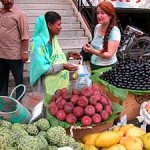 Today we spent the day exploring the streets of Bangalore, shopping for things that we’ll need while living at the ashram. We’ll be three hours north of Bangalore, so it’s a good idea to stock up on necessities while we’re still in the big city.
Today we spent the day exploring the streets of Bangalore, shopping for things that we’ll need while living at the ashram. We’ll be three hours north of Bangalore, so it’s a good idea to stock up on necessities while we’re still in the big city.
While walking through the streets of Bangalore, you find many vendors selling a broad variety of fruit, including mangos and mellons, as well as nuts, like cashews. If you’re a foreigner, it’s important to only eat peeled fruit, otherwise your digestive tract may be in for a big surprise.
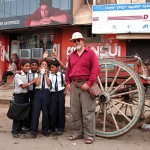
Like any other country in the world, children in India are often curious about foreigners and will quickly gather around you, eager to talk. Sometimes they’re too shy to talk but curious all the same. Usually a smile and a few kind words will quickly break the ice.
Indians are big movie fans. The Indian film industry, sometimes known as Bollywood, produces twice as many films per year as Hollywood. Indian movie stars are practically worshipped as gods but Indians are also big fans of American movies and are very familiar with American film stars. If you want a unique cinema experience, go to a popular Indian movie, starring some of their most famous stars, and be prepared for an audience that responds more enthusiastically than any you’ve ever experienced.
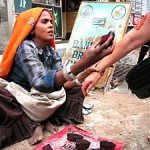 When we encountered the Henna Lady we had no idea what she was selling. We paused for a moment (big mistake) and looked at what she had laid on the ground before her. Suddenly, she grabbed Tara’s hand and began stamping henna designs all over Tara’s arm faster than you could blink an eye. We learned a good lesson. Never go near the Henna Lady.
When we encountered the Henna Lady we had no idea what she was selling. We paused for a moment (big mistake) and looked at what she had laid on the ground before her. Suddenly, she grabbed Tara’s hand and began stamping henna designs all over Tara’s arm faster than you could blink an eye. We learned a good lesson. Never go near the Henna Lady.
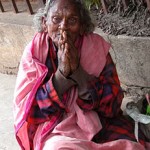 One of the facts of life in India, as in many developing countries, is the presence of beggars, who at times can be very insistent that you give them money. They tend to target foreigners more than local residents because the locals rarely give them money. Often, you’ll be faced with extremely pitiful cases that will break your heart to see. It’s wise to carry a supply of small coins, like one or two rupees to give them, so that they’ll finally leave you alone. If you don’t give them anything, they may follow you for blocks. There’s also an art to giving to beggars. Don’t ever give to them while standing still in one location. Give them a small coin or two while moving and keep moving. Otherwise a crowd may gather making it hard to move on. If you are a sensitive person, dealing with beggars may bring up many emotions that are difficult to deal with but it’s a reality of life. Stepping out of the isolated cocoon of your normal daily existence and facing the reality of the intense suffering being experienced every moment by a large portion of humanity, can be a valuable experience that breaks your heart but opens it as well.
One of the facts of life in India, as in many developing countries, is the presence of beggars, who at times can be very insistent that you give them money. They tend to target foreigners more than local residents because the locals rarely give them money. Often, you’ll be faced with extremely pitiful cases that will break your heart to see. It’s wise to carry a supply of small coins, like one or two rupees to give them, so that they’ll finally leave you alone. If you don’t give them anything, they may follow you for blocks. There’s also an art to giving to beggars. Don’t ever give to them while standing still in one location. Give them a small coin or two while moving and keep moving. Otherwise a crowd may gather making it hard to move on. If you are a sensitive person, dealing with beggars may bring up many emotions that are difficult to deal with but it’s a reality of life. Stepping out of the isolated cocoon of your normal daily existence and facing the reality of the intense suffering being experienced every moment by a large portion of humanity, can be a valuable experience that breaks your heart but opens it as well.
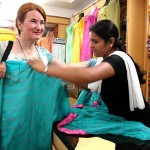 We went to get our “Indian whites,” known as kurtas (for men) and punjabis (for women). That’s what is usually worn at ashrams, or saris for women on special occasions. Actually, once we wore a kurta and punjabi, we wanted to wear them all the time. They’re loose and light and far more comfortable than western clothing. The price is good too. A kurta or a punjabi can be purchased for $10 to $20, and that includes both the pants and the top. While Tara was looking at punjabis, the sales clerk did her best to convince Tara to buy a sari by wrapping saris in a multitude of colors around her.
We went to get our “Indian whites,” known as kurtas (for men) and punjabis (for women). That’s what is usually worn at ashrams, or saris for women on special occasions. Actually, once we wore a kurta and punjabi, we wanted to wear them all the time. They’re loose and light and far more comfortable than western clothing. The price is good too. A kurta or a punjabi can be purchased for $10 to $20, and that includes both the pants and the top. While Tara was looking at punjabis, the sales clerk did her best to convince Tara to buy a sari by wrapping saris in a multitude of colors around her.
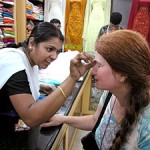 Another Indian custom is that women often wear a bindi, also known as kumkum, mangalya, tilak, sindhoor and by other names. The bindi is a small dot placed between the eyebrows on what is often refered to as the “third eye.” Traditionally, Indian women placed a red dot made with vermilion (finely powdered bright red mercuric sulphide). Nowadays packages of bindis in various colors and designs with adhesive backing can be purchased for a few rupees (cents). When Tara asked the sales girl about how to wear bindis, she went out and purchased several packs of bindis for Tara.
Another Indian custom is that women often wear a bindi, also known as kumkum, mangalya, tilak, sindhoor and by other names. The bindi is a small dot placed between the eyebrows on what is often refered to as the “third eye.” Traditionally, Indian women placed a red dot made with vermilion (finely powdered bright red mercuric sulphide). Nowadays packages of bindis in various colors and designs with adhesive backing can be purchased for a few rupees (cents). When Tara asked the sales girl about how to wear bindis, she went out and purchased several packs of bindis for Tara.
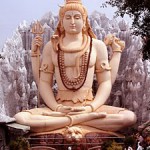 After shopping at Kemp Fort, one of Bangalore’s largest department stores, we walked out the back door and were amazed to see the largest Shiva statue in the world. The statue is sixty feet tall and totally magnificent. We considered this a highly auspicious blessing, since we are beginning our journey into the heart of Mother India. What better way to begin than to receive the blessings of Lord Shiva?
After shopping at Kemp Fort, one of Bangalore’s largest department stores, we walked out the back door and were amazed to see the largest Shiva statue in the world. The statue is sixty feet tall and totally magnificent. We considered this a highly auspicious blessing, since we are beginning our journey into the heart of Mother India. What better way to begin than to receive the blessings of Lord Shiva?
Before leaving this magnificent statue of Shiva, Lord of Yogis, we made a wish that we may grow in wisdom and realize the full capacity of our souls so that we may be more effective in alleviating the suffering of humanity.
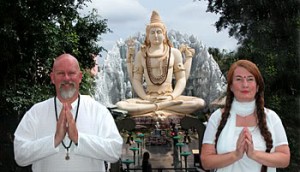














Speak Your Mind